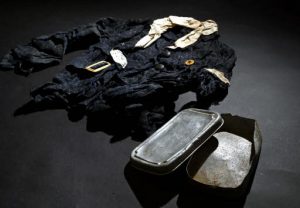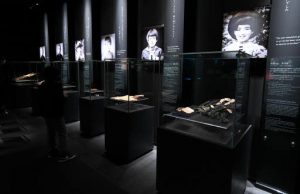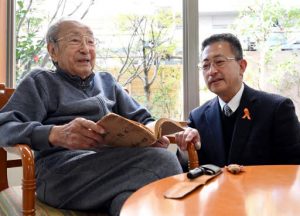Summer uniform and lunch box of girl whose future was cut short added to Peace Museum’s new exhibition
Apr. 5, 2021
by Miho Kuwajima, Staff Writer
The Hiroshima Peace Memorial Museum, located in the city’s Naka Ward, has made major changes to the permanent exhibitions in its main building. Among the newly added items are a summer school uniform and a lunch box donated by Koji Hosokawa, 93, a resident of Naka Ward, which had belonged to his younger sister. As an A-bomb survivor and a surviving family member of a victim of the atomic bombing, Mr. Hosokawa has shared his experience in Japan and overseas for more than 30 years. The artifacts quietly speak of his message: ‘This is the reality of war.’
In the museum’s “Cries of the Soul” section, which introduces the grief and anguish of the bereaved who suddenly lost family members, a misshapen lunch box and a summer school uniform with a patch sewn onto it bearing the words “Student Corps” are displayed in front of a photograph of a smiling girl. The girl’s name was Yoko Moriwaki, then 13, who was Mr. Hosokawa’s sister by a different father. She wore the uniform that day.
Yoko, a first-year student at Hiroshima Prefectural First Girls’ High School (now Minami High School), experienced the atomic bombing at a building demolition worksite around the area that is now Dobashi-cho, Naka Ward, about 800 meters from the hypocenter, and died in a shelter to which she had been carried. Her body, which was taken back to her home in Miyajima, had suffered burns over its entirety, with her clothes blown off by the blast. She had been covered in an informal cotton kimono apparently provided by a stranger.
“At least her face was not burned, for which we should be thankful,” Mr. Hosokawa continued. “Yoko was not the only one. In Hiroshima, many young boys and girls with a future ahead of them were killed,” a message he would like imparted through the exhibit of the articles left by the victims.
The major change in exhibited items is the first since the museum reopened in the spring of 2019, after undergoing full-scale renovation. Now exhibited are 25 items in the “Cries of the Soul” section, 33 in the “Devastation of August 6” section, which shows belongings of students who died in the bombing while helping tear down buildings to create fire lanes, and six A-bomb paintings in the “Emotion Carried by the Brush” section.
Due to aging of the families, those donating articles left behind by victims have changed since the museum’s opening in 1955. Initially, they were the victims’ parents, then siblings, and now families’ grandchildren. With this reality in mind, the work of tracing persons concerned regarding materials donated long time ago has grown harder.
Mr. Hosokawa actively shared his A-bomb account and worked as a Peace Volunteer after retirement, but recently he has been in and out of the hospital. He was expected to speak about his experience to Pope Francis when the pontiff visited Hiroshima the November before last but had to give up on short notice.
In place of Mr. Hosokawa, who now lives in a nursing facility for the elderly, his oldest son, Yo, 61, decided to take over his father’s activities. Yo was the principal of the Hiroshima Prefectural Nishi Senior High School, a correspondence school in Naka Ward, but the school closed last month. After teaching at high schools for about 40 years, he retired and began to take on the issue of his father’s peace activities.
Every summer since he was a young boy, Yo and his family would visit the Peace Memorial Park. There was a photo of Yoko in the family Buddhist altar. Even if Mr. Hosokawa did not say it to him openly, Yo could sense his father’s “survivor’s guilt.” Standing in front of the mementoes of his aunt displayed in the museum’s permanent exhibition, he said that “her precious everyday life was robbed from her instantaneously.”
Mr. Hosokawa keeps Yoko’s diary, written until August 5, 1945, the date before the atomic bombing, at his home along with a fountain pen with which she wrote the entries. He could not bear to part with those two items at the time he donated five other items, including her school uniform and lunch box, to the museum in February 2018. However, he has now changed his mind, as it is now almost impossible for him to go out of the nursing facility. “They will be left without any care if kept in the hands of any one individual. I want them to be stored safely and securely,” Mr. Hosokawa said. He is thinking about donating the items to the museum in the future after first discussing the subject with his son.
(Originally published on April 5, 2021)
Girl’s brother donated artifacts in hopes they would convey A-bomb victims’ message
The Hiroshima Peace Memorial Museum, located in the city’s Naka Ward, has made major changes to the permanent exhibitions in its main building. Among the newly added items are a summer school uniform and a lunch box donated by Koji Hosokawa, 93, a resident of Naka Ward, which had belonged to his younger sister. As an A-bomb survivor and a surviving family member of a victim of the atomic bombing, Mr. Hosokawa has shared his experience in Japan and overseas for more than 30 years. The artifacts quietly speak of his message: ‘This is the reality of war.’
In the museum’s “Cries of the Soul” section, which introduces the grief and anguish of the bereaved who suddenly lost family members, a misshapen lunch box and a summer school uniform with a patch sewn onto it bearing the words “Student Corps” are displayed in front of a photograph of a smiling girl. The girl’s name was Yoko Moriwaki, then 13, who was Mr. Hosokawa’s sister by a different father. She wore the uniform that day.
Yoko, a first-year student at Hiroshima Prefectural First Girls’ High School (now Minami High School), experienced the atomic bombing at a building demolition worksite around the area that is now Dobashi-cho, Naka Ward, about 800 meters from the hypocenter, and died in a shelter to which she had been carried. Her body, which was taken back to her home in Miyajima, had suffered burns over its entirety, with her clothes blown off by the blast. She had been covered in an informal cotton kimono apparently provided by a stranger.
“At least her face was not burned, for which we should be thankful,” Mr. Hosokawa continued. “Yoko was not the only one. In Hiroshima, many young boys and girls with a future ahead of them were killed,” a message he would like imparted through the exhibit of the articles left by the victims.
The major change in exhibited items is the first since the museum reopened in the spring of 2019, after undergoing full-scale renovation. Now exhibited are 25 items in the “Cries of the Soul” section, 33 in the “Devastation of August 6” section, which shows belongings of students who died in the bombing while helping tear down buildings to create fire lanes, and six A-bomb paintings in the “Emotion Carried by the Brush” section.
Due to aging of the families, those donating articles left behind by victims have changed since the museum’s opening in 1955. Initially, they were the victims’ parents, then siblings, and now families’ grandchildren. With this reality in mind, the work of tracing persons concerned regarding materials donated long time ago has grown harder.
Mr. Hosokawa actively shared his A-bomb account and worked as a Peace Volunteer after retirement, but recently he has been in and out of the hospital. He was expected to speak about his experience to Pope Francis when the pontiff visited Hiroshima the November before last but had to give up on short notice.
In place of Mr. Hosokawa, who now lives in a nursing facility for the elderly, his oldest son, Yo, 61, decided to take over his father’s activities. Yo was the principal of the Hiroshima Prefectural Nishi Senior High School, a correspondence school in Naka Ward, but the school closed last month. After teaching at high schools for about 40 years, he retired and began to take on the issue of his father’s peace activities.
Every summer since he was a young boy, Yo and his family would visit the Peace Memorial Park. There was a photo of Yoko in the family Buddhist altar. Even if Mr. Hosokawa did not say it to him openly, Yo could sense his father’s “survivor’s guilt.” Standing in front of the mementoes of his aunt displayed in the museum’s permanent exhibition, he said that “her precious everyday life was robbed from her instantaneously.”
Mr. Hosokawa keeps Yoko’s diary, written until August 5, 1945, the date before the atomic bombing, at his home along with a fountain pen with which she wrote the entries. He could not bear to part with those two items at the time he donated five other items, including her school uniform and lunch box, to the museum in February 2018. However, he has now changed his mind, as it is now almost impossible for him to go out of the nursing facility. “They will be left without any care if kept in the hands of any one individual. I want them to be stored safely and securely,” Mr. Hosokawa said. He is thinking about donating the items to the museum in the future after first discussing the subject with his son.
(Originally published on April 5, 2021)










